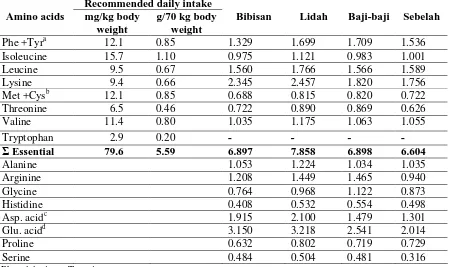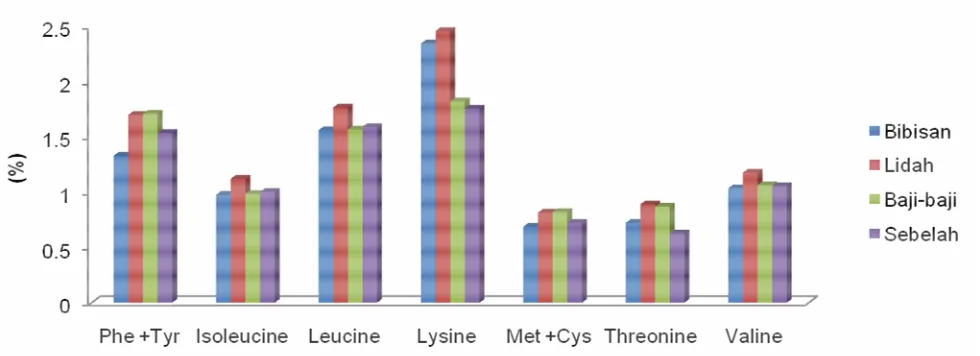International Journal of ChemTech Research CODEN( USA): IJCRGG ISSN : 0974-4290 Vol.6, No.1, pp 311-315, Jan-March 2014
Amino Acids Profiles and Chemical Properties of Four Inferior
Sea Fishes in Madura, Indonesia
Yuli Witono
1*, IwanTaruna
2, and WiwikSiti Windrati
11
Department of Agricultural Product Technology, Faculty of Agriculture Technology,
Jember University, Jl. Kalimantan IJember, East Java, Indonesia 68121.
2
Department of Agricultural Engineering, Faculty of Agriculture Technology, Jember
University, Jl. Kalimantan IJember, East Java, Indonesia 68121.
*
Corres. author: yuliwitono.ftp@unej.ac.id
Abstract:
This study was intended to identify chemical properties and contents of amino acids of four inferior sea fishes in Madura, Indonesia. The studied fishes were ‘bibisan’ (Apogon albimaculosus), ‘baji-baji’(Platycephalidae cymbacephalus), ‘lidah’ (Cynoglossus lingua) and ‘sebelah’ (Psettodes erumei),The contents
of the nutritive substances in the fish products (proteins, ash, and fats) were determined. This study confirmed that in terms of both quantity and quality of the fishes as a significant source of essential amino acids and lysine present in fishes could supplement the corresponding deficiency in plant proteins. The most abundant amino acids in all the fishes were glutamic acid that roles as flavor-enhancing compounds which provide an ‘umami’ (savory) taste in food.
Key words: Amino Acids Profiles and Chemical Properties of Four Inferior Sea Fishes in Madura, Indonesia.
Introduction
Fish is known to be a source of protein rich in essential amino acids (lysine, methionine, cystine, threonine,and tryptophan)1, micro- and macroelements (calcium, phosphorus, fluorine, iodine), fats that are valuable sources of energy, fat-soluble vitamins, and unsaturated fatty acids that, amongst other benefits, have a hypocholesterolemic effect (antiarteriosclerosis).2,3
Free amino acids play an important role in physiological functions such as osmoregulation and buffer capacity in the tissues of aquatic animals4. Their biological roles have been postulated to include the potent intracellular pH buffer capacity control of enzyme activity5, neutransmitter function6, and inhibition of oxidative reactions7. There are 20 amino acids that can be found in the human body, 18 of which are important in human nutrition. Eight amino acid cannot be synthesised de novo by humans and other mammals and hence must be supplied in the diet; therefore they called essential amino acids8. The essential amino acids are lysine,
methionine, threonine, tryptophan, isoleucine, leucine, phenylalanine and valine. Failure to obtain enough of even one of the essential amino acids results in the degradation of the muscle proteins in the body. Moreover, there is a group of amino acids which are not normally required in the diet but which must be exogenously supplied to specific populations under special conditions, such as intensive growth, stress, or in some disease states. Such amino acids have been classified as semi-essential. This group includes histidine, serine and arginine. The remaining amino acids (alanine, cystine, glycine, aspartic acid, glutamic acid, proline and tyrosine) are synthesised by the organism in sufficient amounts and hence are classified as nonessential amino acids9.
A majority of consumers do eat fish, because of its availability, flavor and palatability; while, few do so, because of its nutritional value. Therefore, it can be suggested that taste, size, freshness and other related external appearances should not be the only factors to be considered in making choice for marketing and consumption of the Nile fishes10.
Therefore, the aim of this study was done to identify contents of amino acids of four inferior sea fishes in Madura, Indonesia.
Materials and Methods
Four inferior sea fishes of this study include ‘Bibisan’ (Apogon albimaculosus), ‘Baji-baji’
(Platycephalidae cymbacephalus), ‘Lidah’ (Cynoglossus lingua), and ‘Sebelah’ (Psettodes erumei), were
purchased from the fish market in Talango Island, Sumenep district, Madura, Indonesia.
The determinations of the crude protein and fat, and ash were carried out at the Chemistry and Bio Chemistry Laboratory, Agricultural Product Technology Department, Agricuptural Technology Faculty, Jember University, Indonesia. The chemical compositions of all the samples were determined by the following AOAC (2005) procedures11; crude fat, by Soxhlet extraction with benzene; crude ash, by Incineration in a muffle furnance at 500 oC for 8 hours; crude protein (N x 6.25), by the Kjedahl methods.
Amino acid determinations were carried out at Saraswati Indo Genetech Laboratory Ltd., Bogor, Indonesia. Amino acids in the freeze-dried samples were analysed after acid hydrolysis in 6 N HCl for 22 h at 110oC in glass tubes under nitrogen. Heating is done to accelerate the hydrolysis reaction. Chromatography analysis was carried out using HPLC device, equipped with ion-exchange column and a UV-Vis detector; and post column derivatization with ninhydrin was carried out.
Results and Discussion
The inferiorsea fishes investigated in this present study were Bibisan (Apogon albimaculosus), Baji-baji(Platycephalidae cymbacephalus), Lidah (Cynoglossus lingua) andSebelah (Psettodes erumei). They are the popular market fishes in Madura Indonesia belongs to the economically to the various local grades, depending upon consumers’ preference in this area. Amino acids were the major elements that had been used in assessing in the nutritional value of the study fishes.
Table 1. Chemical characteristics of the four inferior sea fishes in Madura, Indonesia determined. The amino acids compositions of proteins in fishes are shown in Table 2. Seventeen amino acids were identified for each fish. Baji-baji contained the highest percentages of amino acids followed by Bibisan, Lidah and Sebelah (20.720%, 18.268%, 18.225%, and 15.991% respectively). The highest amino acid in all the fishes was glutamic that range from 2.014 – 3.218%; while the lowest AA in Bibisan was Histidine (0.408%); while in Lidah, Baji-baji, and Sebelah was serine (0.504%, 0.481%, and 0.316%, respectively). Seven essential amino acids were identified among the total content of amino acids of all the study fishes (Figure 1). Lidah contained the highest percentage of essential amino acids 7.858%, followed by Baji-baji 6.898%, Bibisan 6.897%, whereas Sebelah revealed having the least content 6.604%.
Table 2. Amino acid composition of the four inferior sea fishes in Madura, Indonesia (g/100 g)
The predominant AAs amongst the non essential amino acids were glutamic acid and aspartic acid, and those amongst the essential amino acids (EAAs) were lysine and leucine. Glutamic acid had important roles as flavor-enhancing compounds which provide an umami (savory) taste in food.Lysine, which is severely restricted in cereals, the most important staple food in the world. A reduced supply of lysine in the diet may lead to mental and physical handicaps because it is an important precursor for the novo synthesis of glutamate, the most significant neurotransmitter in the mammalian central nervous system12.The essential amino acids requirement for adult man weighing 70 kg is about 5.59 g per day13. The results indicated that 100 g of all the study fishes, met the daily requirement for essential amino acids.
Figure 1. Profiles of Essential Amino Acids
Summarizing the results of this study, four inferior sea fishes from Madura, Indonesia can be conclude to serve as significant sources of essential amino acids, in terms of both quantity and quality. Furthermore, the sulphur-containing essential amino acids in the fishes can supplement the corresponding deficiency in plant proteins.
Acknowledgments
We would like to thank the Directorate of Higher Education Ministry of Education and Culture Republic of Indonesia through the Research Grant No.112/SP2H/PL/DIT.LITABMAS/V/2013;13th May 2013 for providing financial support to carry this project.
References
1. Sikorski, Z. E. (1994). Charakterystykabialek –glównychsurowcówzywnos ciowych.InChemiczne i funkcjonalnewlas ´ ciwos ´ ci skladników _ zywnos ´ ci.WN-T, Warszawa.
2. Fernandez, G., andVenkatrammann, J. (1993).Role of omega-3 fatty acids in health and disease. Nutrition Research, 1(Suppl. 13), 19–45.
3. Ismail, H. M. (2005). The role of omega-3 fatty acids in cardiac protection: an overview. Frontiers in Bioscience, 10, 1079–1088.
4. Van Waarde, A., 1988. Biochemistry of non-protein nitrogenous compounds in fish including the use of amino acids for anaerobic energy production. Comp. Biochem. Physiol., 91: 207-228.
6. Boldyrev, A.A. Carnosine as a modulator of endogenous Zn2+ effects. Trends Pharmacol Sci. 22(2001) 112–113.
7. Boldyrev, A.A., Dupin, A., Pindel, E.,and Severin, S. Antioxidative properties of histidine-containing dipeptides from skeletal muscles of vertebrates. Comp. Biochem. Physiol. 89(1988.) 245–250.
8. Hryniewiecki, L. (2000). Bialka.In_ Zywienieczlowieka.PodstawynaukioWydawnictwoNaukowe Warszawa (pp. 176–192).
9. Boisen, S., Hvelplund, T., &Weisbjerg, M. R. (2000). Ideal amino acid profiles as a basis for feed protein evaluation. Livestock Production Science, 64, 239–251.
10. Elagba MHA, Al-Maqbaly R, Mansour HM (2010). Proximate composition, amino acid and mineral contents of five commercial Nile fishes in Sudan. Afr. J. Food Sci., 4(10): 650-654.
11. AOAC (Association of Official Analytical Chemist). 2005. Official methods of the Association of
Analytical Chemist. Virginia USA: AOAC Inc. Airlington, Virginia.
12. Papes, F., Surpili, J. S., Langone, F., Trigo, J. R., &Arruda, P. (2001). The essential amino acid lysine acts as precursor of glutamate in the mammalian central nervous system. FEBS Letters, 488, 34–38. 13. Gawedzki, J., (red). (1997). Bialka w zywnos ci i_ zywieniu.Wyd.AkademiiRolniczej w Poznaniu.
Poznan.

